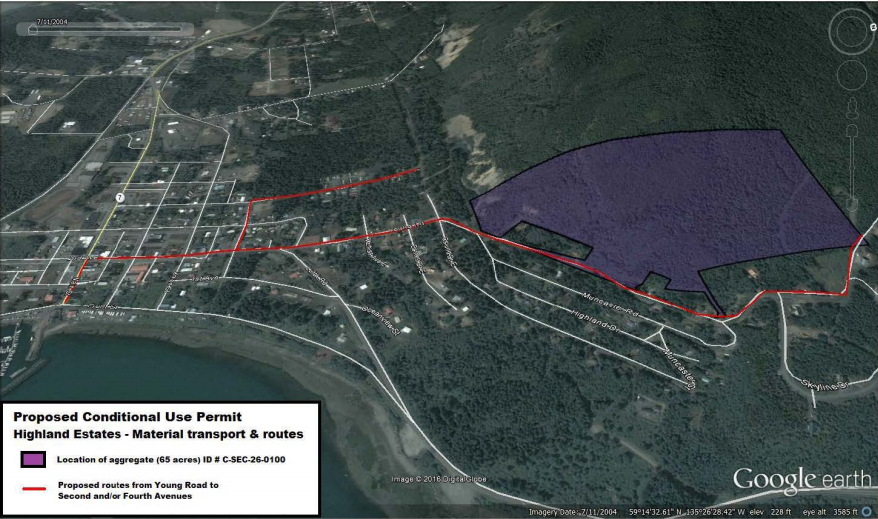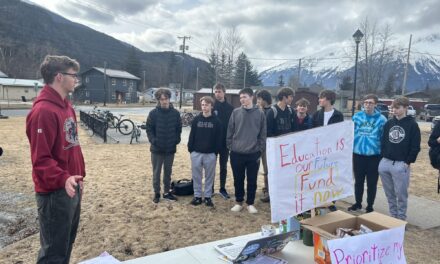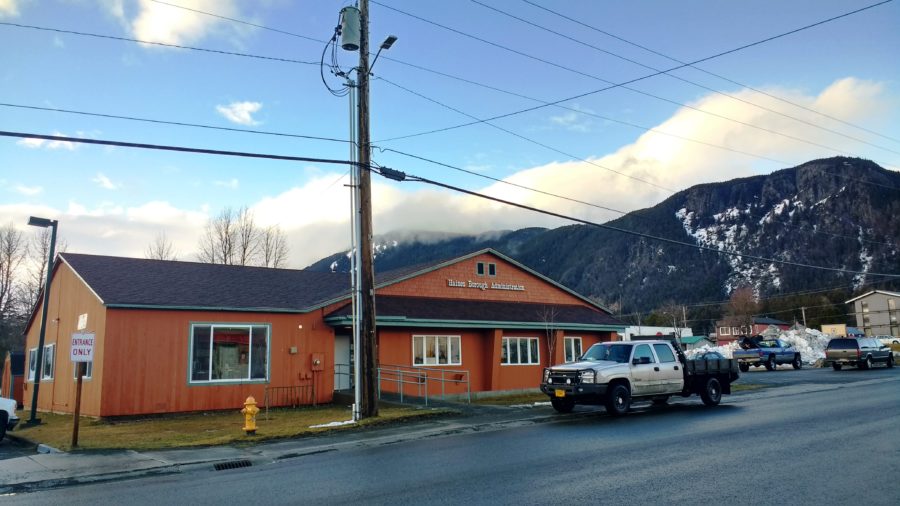
This graphic shows the location of the extraction area in Schnabel’s resource extraction permit.
This story replaces a brief recap posted on Friday 3/17.
The Haines Borough Assembly brought new meaning to the term ‘marathon meeting’ last week. Two citizen appeals of a planning commission decision dragged out the assembly’s regular meeting into a 10-hour, three-day affair. The assembly ultimately upheld the planning commission’s approval of a resource extraction permit. But it also imposed a number of restrictions to address neighbors’ concerns.
In January, Southeast Road Builders owner Roger Schnabel applied for a conditional use permit. He wants to extract 7,500 cubic yards of rock material from his property above Skyline Drive and bring it directly to the ongoing harbor expansion project for commercial sale. The work would involve, drilling, blasting and trucking.
“I am in a position now where a nice situation has showed up which is a nice marriage and that marriage is to move the material as I’m developing that down to the harbor project in the form of riprap,” Schnabel said. “And the marriage is so sweet from the standpoint that it’s neighborhood-friendly.”
But there are a number of people who live near Schnabel’s property who do not think it is ‘neighborhood-friendly.’
“I don’t consider the project neighborhood-friendly at all,” said Lenise Henderson-Fontenot. “My idea of neighborhood-friendly is not blasting and trucking and that type of thing.”
Henderson-Fontenot filed an appeal after the planning commission approved Schnabel’s conditional use permit.
To get a conditional use permit, an applicant has to meet eight criteria. Henderson-Fontenot said Schnabel’s permit did not meet those standards. She said the blasting and trucking would hurt property values, pose safety hazards, and degrade residents’ overall quality of life.
“I don’t think [the planning commission] followed process and that’s kind of where I’m standing with this,” said Assembly member Margaret Friedenauer.
Friedenauer found fault with the way the planning commission treated Interim Borough Manager Brad Ryan’s recommendations. Ryan proposed a list of restrictions for Schnabel’s permit to mitigate harmful impacts.
“I mean, an excerpt from the tape actually says ‘let’s eliminate the part about roads, are you OK with that Roger?’” Friedenauer said, referring to tape of the planning commission meeting. “And to me that goes against what the planning commission was supposed to consider in code.”
Friedenauer said the commission seemed to remove conditions without looking at how they would align with code.
The assembly voted unanimously to reinstate the manager’s recommendations and add a few new ones. That includes changing the permit from three years to one and adherence to a traffic and pedestrian safety plan.
But the discussion on Schnabel’s permit didn’t end there. A second appeal, from neighborhood resident Ella Bredthauer, was set for a hearing of its own. The assembly extended its meeting to the next day, Wednesday, for the second hearing.
“This approved permit as it stands now has dramatic potential to endanger the health and safety of all those near the proposed truck route,” Bredthauer said. “Discounting or ignoring these safety concerns would amount to negligence on the borough’s part. In its current form, this permit does exactly that.”
Bredthauer said the permit should not have made it past the approval process. She pointed to code that says the burden of proof is on the developer to meet the conditional use criteria. Bredthauer said Schnabel did not do that and neither did the planning commission.
She brought up a number of other objections and questioned Schnabel’s stated intent to develop the property as a residential subdivision.
“The intent isn’t necessarily residential development,” Bredthauer said. “It’s resource extraction for the purpose of providing riprap for the Haines Borough harbor project.”
In his response, Schnabel defended his plans. He said this conditional use permit was another step to ‘get the lay of the land’ for residential development. Schnabel said he wanted to increase property values in the neighborhood with a ‘first-class’ subdivision.
“We all have a real benefit in my opinion with Roger Schnabel owning that property, because it’s me,” Schnabel said. “Roger Schnabel’s gonna be involved in the development of it. And so if there’s any issues that are going to take place, right here’s the answer.”
The assembly wasn’t sure what it could legally do with the second appeal, because it had already made a decision on the first one.
“I left the meeting last night thinking we’d done the right thing,” said Assembly member Heather Lende. “Which I still, in many ways, believe we’ve done the right thing. I question though whether we’ve done the legal thing. And I appreciate Ella very much bringing us right back to code.”
The assembly decided it needed to talk to the borough attorney. So, it extended the meeting to a third day. On Friday, the assembly teleconferenced with the attorney for about two hours behind closed doors.
After that, the assembly made its final decision. First, it consolidated the two appeals. Then, the assembly made a similar decision to its first one. It upheld the planning commission’s approval but reinstated the manager’s recommendations, added the restrictions it came up with on the first day, and included a couple new conditions.
Schnabel will now have to work with the borough to create not just a safety plan, but also a reclamation plan. He will also have to allow a compliance monitor to observe his work. Those are just some of the new restrictions.
Assembly member Lende said she hoped this was a compromise everyone could live with. Schnabel says he plans to follow the conditions to complete his work. Bredthauer says she is withholding judgment until she sees how much the public is involved in the newly-required safety and reclamation plans.








